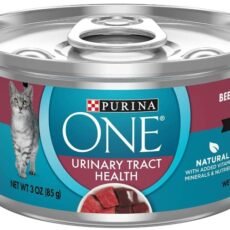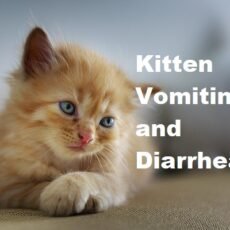As any cat owner knows, cats can be picky eaters. Moreover, each cat has unique dietary needs based on age, health, and activity level. Therefore, knowing what to feed cats and having access to the best cat feeding advice can be challenging.
The food you give them, how much you feed them, and when you feed them can impact their health. That’s why it’s essential to have some basic knowledge about cat feeding.
By understanding the basics of cat nutrition, you can ensure that your cat gets the nutrients they need to stay healthy. This article will give you tips for caring for your feline friend. Keep reading for more information.
What to Feed Cats
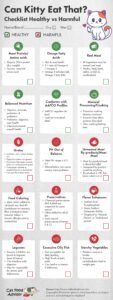 Knowing what is healthy for cats is just as essential as being aware of ingredients that are harmful for cats.
Knowing what is healthy for cats is just as essential as being aware of ingredients that are harmful for cats.
Some cat food manufacturers compromise their pet products in order to keep costs down for the consumer. They may incorporate into their cat food formulas such things as inferior meats, artificial flavoring and grain fillers. All of these can be harmful to your cat’s health.
We strongly suggest that pet owner’s carefully read the cat food labelling of commercial cat foods to establish whether or not the food is right for your pet.
To help our viewers we have developed a simple to use Cat Food Appraisal Tool that presents a 16 point checklist. Use this tools when shopping for cat food. Our appraisal tool is available in PDF form HERE. To see a detailed breakdown of cat food ingredients view our article ‘What to Look for in Cat Food- the Good and The Bad’.
7 Cat Feeding Advice Tips
Assuming your cat is healthy and has no special dietary needs, here are some tips to help you choose the right food and feeding schedule.
1. Type of Food
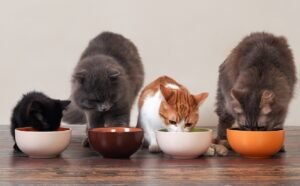 You first need to consider what type of food to feed your cat. The two main options are dry food and wet food.
You first need to consider what type of food to feed your cat. The two main options are dry food and wet food.
Dry food is typically cheaper and easier to store but has less moisture than wet food. If your cat doesn’t drink enough water, dry food can lead to dehydration.
On the other hand, wet food is more expensive but contains more moisture. It’s also generally closer to a cat’s natural diet.
The best option is to feed your cat a combination of both dry and wet food. This way, they can get the benefits of both types of food.
2. How Much to Feed Them
Most cats need around 20 calories per pound of body weight per day. So, if your cat weighs ten pounds, they need about 120-180 calories daily.
Of course, this number will vary based on age, activity level, and other factors. Talk to your veterinarian if you’re unsure how much to feed your cat. They can help you figure out the right amount based on your cat’s individual needs.
3. When to Feed Them
The best feeding schedule for cats is two or three small meals per day. If you only feed them once a day, they’re more likely to gorge themselves and then not eat again until the next meal.
However, some cats do better with one big meal per day. It depends on your cat’s individual preferences. Experiment to see what works best for them.
Generally, it’s best to feed them in the morning and at night. This way, they have food in their stomachs overnight.
If you work long hours and can’t be home to feed them twice a day, consider investing in an automatic feeder. This way, their meals will be dispensed on a schedule, even when you’re not home.
4. Water
In addition to food, cats need plenty of fresh water. So make sure they always have a clean bowl of water that’s easily accessible.
Some cats don’t like to drink from a bowl and prefer running water. In this case, you can need a cat water fountain, and Tomxcute Cat Water Fountain is one of the best for your cat. These fountains filter the water and keep it circulating, so it’s always fresh.
Cats typically need around five ounces of water per day. This number will increase if they eat primarily dry food or live in a hot climate.
5. Feed them a Balanced Diet
Cats are obligate carnivores, so they need to eat meat to survive. Meat contains an essential amino acid (Taurine), that cats require in their diet and are unable to synthesise themselves. Therefore, their diet should be high in meat protein and low in carbohydrates.
That said, not all cat foods are created equal. For example, some contain more fillers and by-products than others. So, it’s essential to read the labels carefully before buying anything. Refer to our Cat Food Appraisal Tool which provides a simple checklist on what to look for in a healthy cat food.
The best cat foods will list real meat as the first ingredient. Avoid anything that contains grains, corn, or soy. These are challenging for cats to digest. Here is a sample of grain free cat foods.
6. Treats
In addition to their regular food, you can also give your cats treats. However, treats should only make up around five percent of their diet. The rest should be high-quality cat food.
When choosing treats, look for something high in protein and low in carbohydrates. You can give them small pieces of cooked chicken or turkey as a healthy treat.
You can also find commercial cat treats specifically designed to be healthy and nutritious.
7. Keep Better Hygiene
It’s essential to keep your cat’s food area clean. Wash their bowl with soap and water every day.
Every week or so, you should disinfect their bowl with a mixture of one part vinegar and three parts water. This will help kill any bacteria that could make them sick.
After washing and disinfecting their bowl, rinse it well and dry it before adding fresh food.
Interesting Facts About The Cat
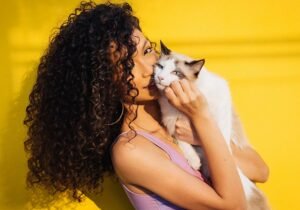 Cats are fascinating creatures that have been domesticated for thousands of years. They are known for their independent nature, as well as their Hunter’s instincts.
Cats are fascinating creatures that have been domesticated for thousands of years. They are known for their independent nature, as well as their Hunter’s instincts.
Despite this, cats are excellent companions and affectionate towards their owners. Here are some fun facts about our feline friends:
Cats have been domesticated for over 4,000 years. The first recorded instance of cat domestication comes from Ancient Egypt, where they were revered as gods and kept as pets.
- There are over 500 million domestic cats in the world.
- Cats sleep for around 12-16 hours a day.
- While most cats are right-pawed, around 50% are left-pawed.
- The average lifespan of a domestic cat is around 12-18 years, although some can live into their 20s.
- Cats have excellent night vision and can see six times better than humans in low light conditions.
- A cat’s hearing is much sharper than ours, and they can detect high-frequency sounds we cannot hear.
- Cats have whiskers on their face which are extremely sensitive and help them judge distance and navigate in the dark.
- Cats have a powerful sense of smell and can remember smells for long periods.
Common What to Feed Cats Questions
You may be interested in articles we have provided that answer the following what to feed cats questions:
Can cats eat chocolate?
Sharing a bar of chocolate with your pet cat is a bad idea as it is harmful to them. Chocolates present a severe health risk to cats and may be life-threatening if consumed excessively. Read on here…
Can cats eat dog food?
It is one of those reoccurring questions veterinarians hear from cat owners. Although the straightforward answer to this common question is yes, there is more cat owners need to know. Read on here…
Is human food OK for cats?
Your cat’s affection may motivate you to share that snack with your little friend. However, there is more to understand before submitting to the urge of feeding your cat human food. Read on here…
Can cats eat fruit?
Fruit form a healthy and needed part of the human diet, but is it the same for our feline friends? While you can include a little fruit in your cat’s diet, you must stick to safe fruits. Unfortunately, not all fruit is safe for cats. Read on here…
Is cows’ milk healthy for cats and kittens?
Images of cats lapping a bowl of milk have imprinted the impression that cow’s milk must be good for every cat. While most cats crave a little milk, the supposed love between cats and cow milk is exaggerated. Read on here…
Can cats eat canned tuna?
The short answer is Yes, canned tuna is considered safe to feed cats. Read on here…
What meat can cats eat?
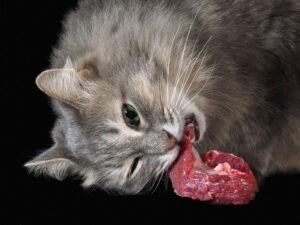 By nature, cats are carnivorous meat-eaters with meat forming an essential part of their diet. However, it would help to consider what meat cats are best to eat before offering your pet that morsel of meat. Read on here…
By nature, cats are carnivorous meat-eaters with meat forming an essential part of their diet. However, it would help to consider what meat cats are best to eat before offering your pet that morsel of meat. Read on here…
Can cats eat raw meat?
Absolutely. Cats are obligate carnivores. So it is understandable when pet owners want to give a raw diet to their cats. However, some experts say that placing your cat on a diet of raw meat causes a significant health risk for you and your pet. Read on here…
Final thoughts on what to feed cats
Now that you know what to feed cats, it’s time to start. Choose the right food, create a feeding schedule, and clean their bowl. With this cat feeding advice your cat will be healthy and happy for years.
Go check our article on what we consider to be the worst cat food ingredients found in cat foods.






